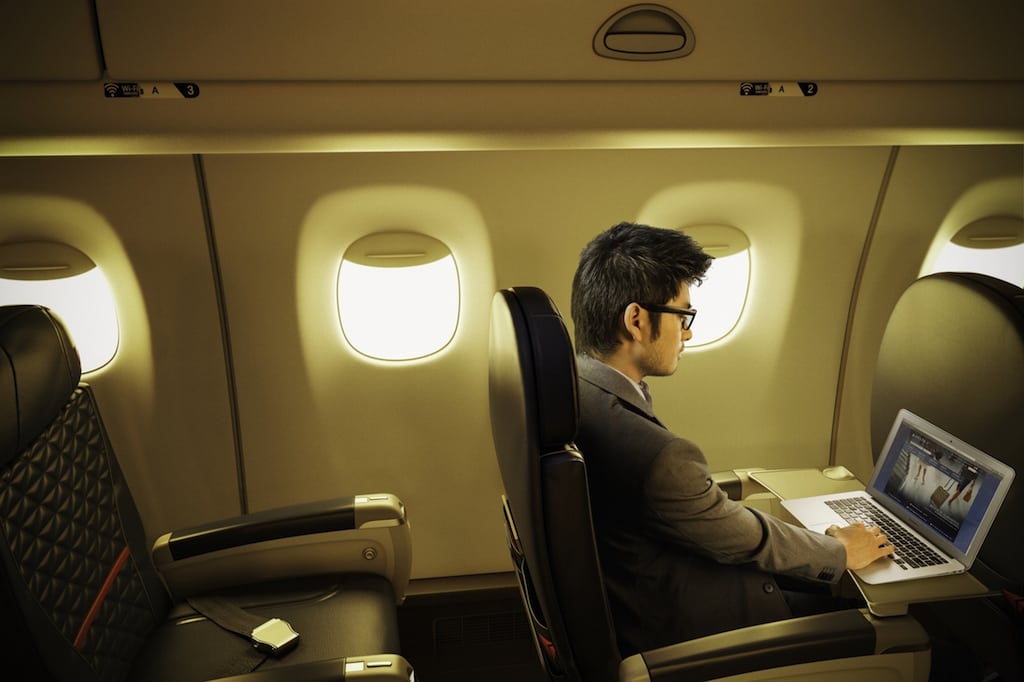Skift Take
For years, airline passengers have hated Gogo's air-to-ground, or ATG, service. But change is coming, and travelers soon may not need to curse when they learn they're on an air-to-ground-equipped airplane.
Delta Air Lines CEO Ed Bastian sometimes jokes he calls Gogo, “no-go,” when he speaks to the in-flight internet company’s chief executive.
Delta was an early mover in Wi-Fi almost a decade ago, but because it was so soon, it installed what several years ago was the only viable option for domestic routes — Gogo’s air-to-ground system, or ATG, which relies on a network of more than 200 ground-based cell towers.It was good enough for the the vast majority of domestic flights when airlines mostly sold internet to business customers who used it to check email. But although Gogo’s air-to-ground system has been updated, it’s not appropriate for 2018’s heavy users.
Delta, like many airlines, is investing in satellite coverage, adding Gogo’s speedy 2KU system to many planes. It’s a system Gogo is selling worldwide, and it could be installed on more than 1,000 aircraft by year-end, a company spokesman said. The benefit of satellite, both from Gogo and its competitors, is that it works nearly everywhere, including when flying over oceans. And passengers like it, because they often can stream content — assuming airlines don’t block the functionality.
The conventional wisdom is that the air-to-ground era is over. But that’s not true. Gogo is overhauling its much-derided air-to-ground product, promising it soon will produce comparable speeds to the company’s satellite network, and likely at a cheaper cost. While it should be available later this year, no airline has committed to installing what Gogo calls ATG-NextGen.
“The industry has made the claim that satellite is better,” Steve Nolan, Gogo’s vice president for communications, said in an interview. “We are kind of technology agnostic about this. Not every aircraft flies the same routes. Not every aircraft has the same technology needs or is capable of carrying the same technology.”
Today’s technology, called ATG4, delivers about 9.8 megabits per second to each airplane, according to Gogo. By using unlicensed spectrum, a new modem and a modern antenna, Gogo estimates it can deliver peak speeds greater than 100 megabits per second. Gogo’s previous air-to-ground systems have relied on spectrum the company owns.
Limited Coverage Area
The only clear issue is coverage area. Gogo may have solved the speed problem, but it’s never going to fix the other issue with air-to ground — it only works in North America, and only when planes fly above connected cell towers. That’s long been an annoyance to Gogo customers flying to Hawaii because they have no coverage on an otherwise connected aircraft.
Once, airlines tolerated coverage holes. They might ask flight attendants to make an announcement that Wi-Fi wasn’t available. But in 2018, passengers expect constant connections, so now Gogo is focused on selling ATG for planes that rarely, if ever, leave the continental United States. Mostly, that means regional jets operated by American Eagle, United Express and Delta Connection, though Nolan said it might include some mainline jets. Other planes should get satellite service.
For airlines, air-to ground has several benefits. Airlines can install the technology faster than satellite retrofits, usually during overnight maintenance visits. And since so many United Express, American Eagle, and Delta Connection planes have an earlier version of the platform, upgrading it is easy.
“The incremental hardware needs are relatively trivial compared to the potential benefits to airlines and passengers,” Seth Miller, an industry analyst and blogger, said in an email. He said he expects airlines will upgrade to the service relatively quickly. Gogo’s Nolan said the company expects some airlines should have planes flying with it by 2019.
Gogo’s claims its new platforms, whether satellite or air-to-ground, can deliver an at-home experience, but Miller said he’s skeptical, calling it a “long-shot.”
“Consumer consumption on the ground continues to grow just as quickly as additional services are added for aircraft,” he said. “We are unlikely to realize sufficient total capacity on a plane for everyone to have the truly at-home experience. But the continual increase in bandwidth delivered to planes does mean that the experience will continue to improve for passengers and airlines.”
The Daily Newsletter
Our daily coverage of the global travel industry. Written by editors and analysts from across Skift’s brands.
Have a confidential tip for Skift? Get in touch
Tags: airline innovation, airline passenger experience, gogo
Photo credit: Delta Air Lines is upgrading much of its fleet to satellite WiFi, but it has not said much about its regional jets. Pictured is a business traveler on a Delta Connection E175. Delta Air Lines
